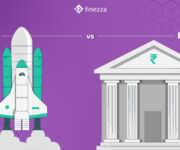Technology makes it easy for companies to open the floodgates of the financial system to the masses; mobile banking is the proof. Moreover, fintech (of which mobile banking is a part) has revolutionised the banking sector, forcing it to undergo changes that would otherwise be daunting.
But now, we live in the era of customised banking services with a solid digital infrastructure. And new technologies have just started emerging, which means we are up to visualising major game-changing products, features, and services, especially in the developing nations.
We have heard numerous mobile banking innovation stories from across the world, such as NPCI’s Interbank Mobile Payment Service (IMPS), M-Pesa, etc.
With an early mover advantage, they changed the face of banking in developing nations. But, perhaps, they are just getting started in the fintech space.
Mobile Banking Is Helping Build Resilient Nations
In developing nations like India, access to banking services in remote areas is close to nil. But mobile banking helps channel the power to equip people with banking services, turning financial inclusion into a reality.
Mobile banking, aka mobile money, is a possible channel for providing banking solutions through cell phones.
Customers can, through their mobile phones make deposits, and withdrawals, transfer money from accounts, pay bills, and place balance inquiries. The latest additions to this facility are investment options and other schemes.
Moreover, in the difficult times that we have encountered, mobile banking made it easier to thrive through the challenges. For example, after the pandemic, 8 out of 10 Indians are now reliant on mobile banking apps. This digital adoption can safeguard people from uncertain times and challenges, even in the future.
With no barriers to location, people can become self-reliant and avail of financial services according to the need of the hour.
Developing Nations are Ahead in Mobile Banking Game
Developing countries have, in a way, outsmarted developed nations in mobile banking development; history is the proof.
Being the gateway to financial inclusion, the developing nations are reaping an infrastructure reliant on mobile banking.
On the other hand, developed nations heavily depend on cash transactions and other safe mediums like cards.
The rock-solid banking framework makes the process relatively rigid in developed nations and less likely to sooner digital adoption.
This is why developing nations are jumping into the bandwagon of digitisation, even before developed countries can plan implementation.
Tie-Breaker Innovations In the World Of Mobile Banking
Starting from NPCI’s person-to-person mobile banking and B2B mobile banking, we have come a long way. Here are the latest innovations to the world of mobile banking:
APIs
APIs, aka Application Programming Interfaces, allow two software apps, systems, and other services, including third-party services, to communicate.
This translates to communication amidst banks and 3rd party products in the banking ecosystem, ensuring utmost security.
Done right, banks could achieve integration between multiple channels, apps, services, devices, and more. This facilitates processes like customer mobile wallets, card systems, 3rd party financial service providers, payment switches, etc.
Instant payments
Real-time, convenient, cheap, and effortless payment services are the hype now, or our way of post-pandemic life. This shattered the rather traditional process of transfer in 3 business days.
In addition, the transaction prompts such as email, push notifications, account updates, and other requisitions are now real-time.
Biometric
Taking extreme security cautions, banks have integrated human physical characteristics (such as fingerprints, iris, and voice) to identify specific customers and their account belongings.
Biometrics is highly secure because there is no downside, such as losing or forgetting passwords. Biometrics are also less easy to crack for hackers and act as the best firewall.
Chatbots, AI, ML, and automation
Gone are the days when customers waited in queues and called to seek their query resolution. Instead, chatbots are built using AI technology to connect with people and provide answers to their queries in real-time.
They are the digital agents deployed at services in multiple channels like websites, live chat, social media, etc.
Banking organisations have leveraged AI and machine learning to aid cost-saving, productivity, and process improvement.
Banking services are now automated, sparing employees the hassle of manual processes. Repetitive human tasks are now delegated to machines and systems capable of doing the job in less time. This makes it easy for both employees and customers with fewer chances of errors.
Data analytics
Banks are the repositories of customer data. They now rely on data collected and sourced through customers to pinpoint preferences and choices.
This makes it easy for banks to offer detailed and tailor-fit services and products to their customers. To attain customer engagement, personalisation is the mantra banks are now operating on.
Is Mobile Banking Free From Any Setbacks?
Unfortunately no, mobile banking has its share of critiques, challenges, and risks.
Mobile banking is the path to financial inclusion, not a solution to financial setbacks. Here are some of the challenges to be aware of:
Infrastructure – Like brick-and-mortar branches, mobile banking relies on telecom operators’ infrastructure. Therefore, any shortfall in the alignment of such operators affects mobile banking services.
Internet connectivity is still a challenge in many remote areas of developing nations, and the success rate relies on internet coverage.
Operational barriers – Security in mobile banking is still a concern for the leaders and users. Mobile transactions are prone to fraud and fall prey to data breaches.
Any shortfall can economically affect either party of the transactions, a significant threat to watch out for.
Regulatory roadblocks – The mobile banking process connected with the risks are still not open for resolution in legal terms. Policymakers and relevant stakeholders can still not find a middle ground where they can agree on constructing parameters that would help build a network or market. The end-to-end process of building a secure gateway of mobile banking is a work in progress with no final layout of approval.
Even with the setbacks, mobile banking portrays a solid blueprint for the facilitation of financial inclusion. The pandemic is the primary driver of this process and is also proof enough for us to incorporate it into our lives. The usage is already widely noticed across all areas of developing nations.
Mobile banking has spun the wheels of change around for the banking industry, taking charge of the driver’s seat. Stay abreast of the mobile banking trends by following Finezza’s blog.




Leave a Reply